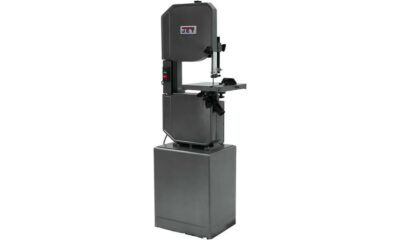Home Decor
10 Stunning Topiary Ideas for Your Garden
Fantastical garden designs await with these 10 stunning topiary ideas that will transform your outdoor space into a whimsical wonderland.
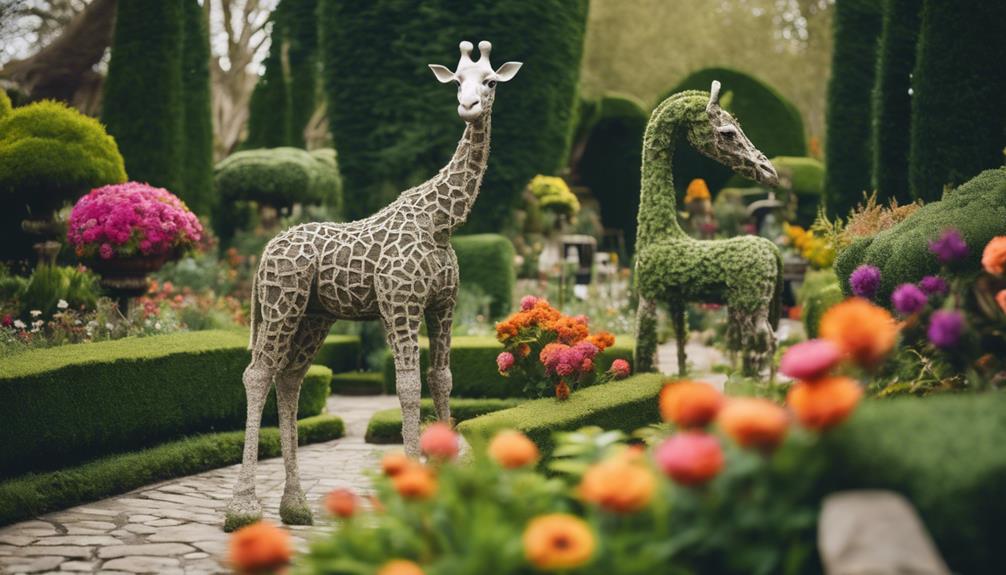
You can transform your outdoor space into a vibrant, whimsical, or elegant oasis with topiary designs. From playful animal shapes to sleek geometric forms, there are countless ways to create a stunning garden. Try whimsical woodland designs featuring animal shapes, or create a modern look with geometric shapes like cubes and spheres. Use container topiary ideas for flexibility and versatility, or create a focal point with topiary sculptures. Discover elegant entrance designs, nature-inspired creations, and unconventional shapes like clouds or waves. As you explore these 10 stunning topiary ideas, you'll uncover even more inspiration to shape your garden's unique charm.
Key Takeaways
• Whimsical woodland topiary designs featuring animal shapes can add a playful and enchanting element to your garden.
• Geometric shapes like cubes, spheres, and cones can create a modern, sleek look and replicate the serene ambiance of Japanese-inspired gardens.
• Creative container topiary ideas can provide flexibility, versatility, and low maintenance, making them ideal for small spaces.
• Topiary sculptures can be used as unique focal points or accents in the garden, evoking a sense of wonder and curiosity in visitors.
• Elegant entrance topiary designs can frame doorways with tall, slender topiaries, setting the tone for a beautiful and inviting outdoor space.
Whimsical Woodland Topiary Designs
What kind of whimsy can you bring to your garden with woodland topiary designs that feature playful animal shapes like rabbits, birds, and squirrels?
Whimsical woodland topiary designs can add a playful and enchanting element to your garden space. These topiary designs often feature animal shapes, which can be a focal point or scattered throughout the garden for a whimsical touch.
Common plants used for woodland topiary include boxwoods, yews, and privets, which are easy to shape and maintain. By incorporating woodland topiary designs, you can create a magical and fairytale-like atmosphere in your garden.
Imagine strolling through your garden and coming across a beautifully shaped rabbit or bird, adding a touch of wonder to your outdoor space. With woodland topiary designs, you can bring a sense of fantasy and playfulness to your garden, making it a unique and inviting space for you and your guests to enjoy.
Geometric Shapes for Modern Gardens
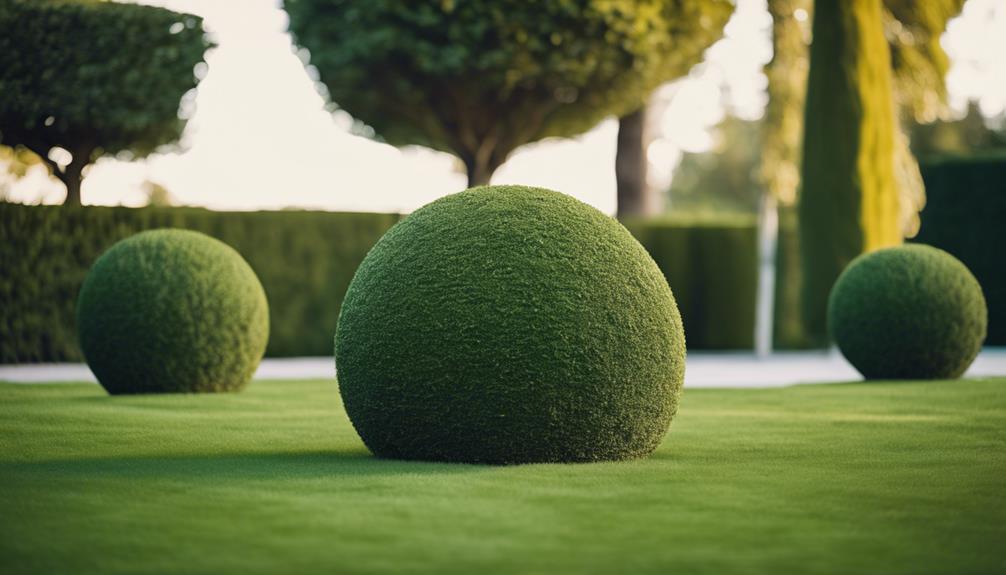
By moving away from whimsical woodland creatures, you can create a modern and sleek look in your garden with geometric topiary designs that incorporate clean lines, symmetry, and precision-cut shapes.
Geometric shapes like cubes, spheres, and cones are popular choices for modern topiary designs, offering a contemporary twist on traditional topiary.
You can replicate the serene ambiance of Japanese-inspired gardens by incorporating Oriental shaping with clipped evergreens, creating a peaceful atmosphere in your outdoor space.
For a more unique and artistic touch, consider planting a topiary forest with various geometric shapes, adding visual interest to your garden.
Alternatively, use frames with wire templates hidden inside topiary to create intricate and customizable designs.
Topiary shapes can also be used to elevate the visual appeal of your outdoor space, such as designing a decorative topiary hedge on top of privacy hedges.
With geometric shapes, the possibilities are endless, and the result is a modern, sophisticated garden that showcases your personal style.
Creative Container Topiary Ideas
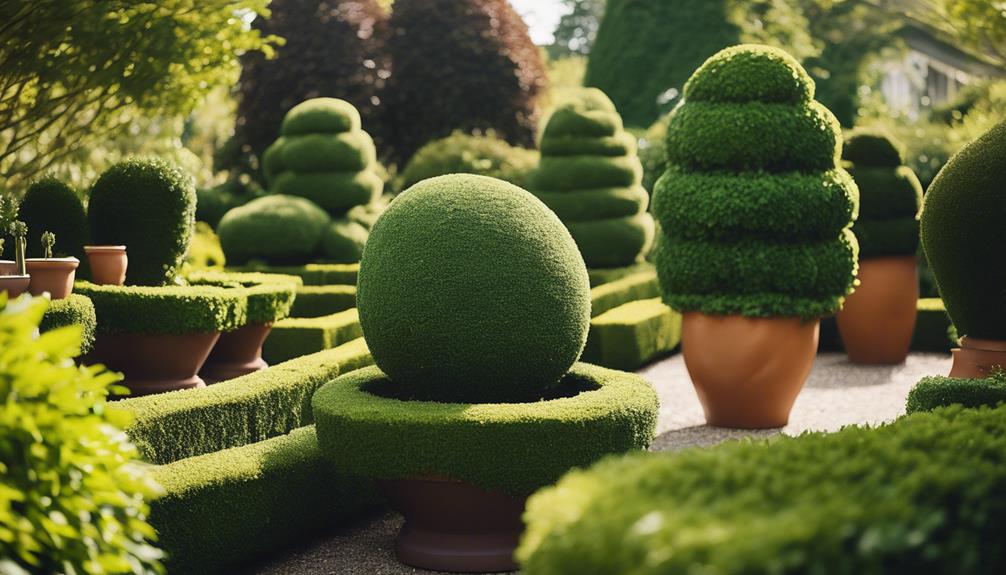
As you explore creative container topiary ideas, you'll discover the versatility of this art form. From compact spaces to whimsical designs, container topiary can elevate your garden's style and charm.
Let's examine some inspiring examples, including Small Space Wonders, Mixed Greens Delight, and Whimsical Container Picks, to spark your imagination and creativity.
Small Space Wonders
With limited garden space, you can still indulge in the elegance of topiary with creative container ideas that bring a touch of greenery to even the smallest of areas. One of the biggest advantages of container topiary is its flexibility – you can move and rearrange your plants as needed in your garden. Plus, various plants like boxwoods, lavender, and hebe can be shaped into beautiful topiary designs in containers.
| Container Topiary Benefits | Description |
|---|---|
| Flexibility | Move and rearrange your plants as needed in your garden |
| Versatility | Place on patios, balconies, or even indoors for a decorative touch |
| Low Maintenance | Easily maintained and pruned to keep them looking neat and well-shaped |
Mixed Greens Delight
Combine a medley of green hues and textures by incorporating different plants like boxwoods, yews, and hollies into your container topiary design. This creative approach will add depth and visual interest to your outdoor space. As you design your mixed greens delight topiary, consider the growth habits and maintenance requirements of each plant species. You'll want to choose plants that thrive in similar conditions and have similar pruning needs.
Experiment with different shapes and sizes of containers to showcase your mixed greens delight topiary. A unique container can elevate the overall aesthetic of your design. When selecting plants, think about the varying shades and textures of green foliage you can incorporate. For example, boxwoods offer a soft, delicate texture, while yews provide a more dramatic, upright shape. Hollies, with their prickly leaves, add a touch of whimsy.
Whimsical Container Picks
Select a show-stopping planter that complements your topiary's unique shape and style to create a whimsical container pick that instantly elevates your outdoor space.
When it comes to container topiary ideas, the possibilities are endless. You can choose from a variety of containers, such as pots, urns, and decorative planters, to add a touch of personality to your topiary garden.
The beauty of container topiary is that it allows for easy mobility and flexibility in design placement, making it perfect for small spaces or areas where traditional ground planting isn't feasible.
Consider mixing and matching different plant shapes, sizes, and colors in containers to create a unique look that reflects your personal style. By doing so, you'll be able to create a visually appealing topiary arrangement that adds a touch of whimsy to your outdoor space.
With container topiary, the possibilities are endless, and you can easily switch up your design as the seasons change or as your style evolves.
Topiary Sculptures for Garden Accents
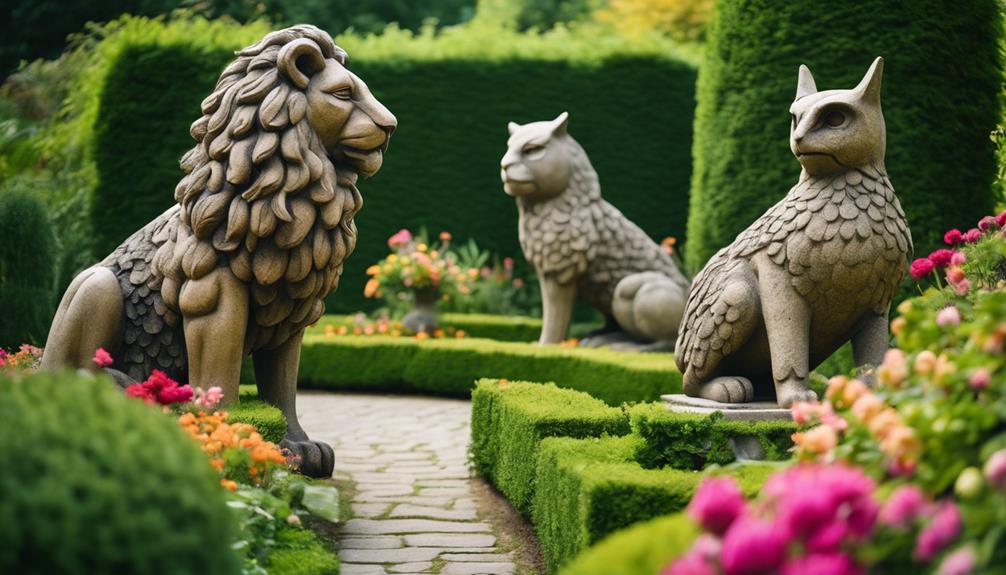
As you explore the world of topiary sculptures, you'll discover that animal shapes can bring a playful touch to your garden, while whimsical garden forms can add a touch of magic.
From majestic birds to mythical creatures, the possibilities are endless, and the right design can elevate your outdoor space.
Animal Shapes Delight
By incorporating animal-shaped topiary sculptures into your garden design, you can infuse your outdoor space with a touch of whimsy and personality. These charming creations can add a playful and magical atmosphere to your Topiary Gardens, making them a standout feature. To create these delightful sculptures, shrubs like boxwood are carefully pruned and shaped into various animal forms, such as birds, rabbits, dogs, and even elephants.
Some benefits of incorporating animal-shaped topiary sculptures into your garden design include:
- Adding a touch of whimsy and personality to your outdoor space
- Creating a playful and magical atmosphere in your Topiary Gardens
- Providing a unique focal point or accent in your garden design
- Evoking a sense of wonder and curiosity in visitors
Whimsical Garden Forms
You can elevate your garden's visual appeal with whimsical garden forms, which are topiary sculptures that add a touch of artistic flair and personality to your outdoor space. These unique sculptures can be designed to reflect your personal style, making your garden stand out from the rest.
With the help of a skilled topiary specialist, you can create intricate designs that serve as focal points, accents, or even functional elements in your garden. From simple geometric shapes to intricate animal figures, the possibilities are endless. Topiary artistry requires skillful pruning and shaping of plants like boxwoods, yews, and hollies, which can be time-consuming but yields stunning results.
Elegant Entrance Topiary Designs
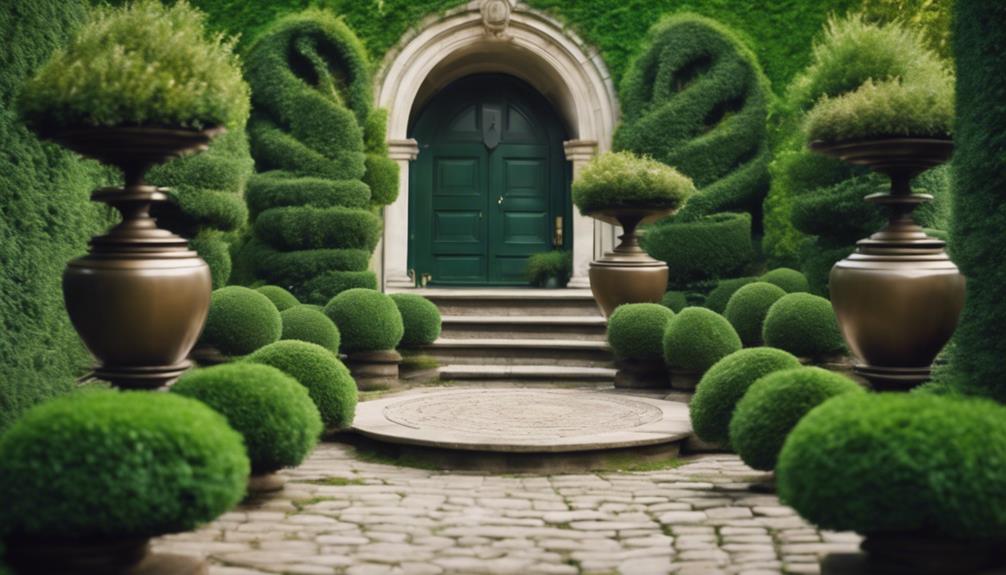
Create a stunning first impression by framing your doorway with tall, slender topiaries that exude elegance and sophistication. These large topiaries will set the tone for a beautiful and inviting outdoor space.
To create an elegant entrance, consider the following design elements:
- Use spiral or cone-shaped topiaries for a classic and sophisticated look that adds visual interest to your doorway.
- Enhance the entrance with topiaries in decorative containers for a stylish touch that adds color and texture.
- Opt for evergreen plants like boxwood or yew for year-round beauty and structure that will withstand the seasons.
- Add lighting to highlight the topiaries and create a welcoming ambiance at night that will make your home feel cozy and inviting.
Nature-Inspired Topiary Creations
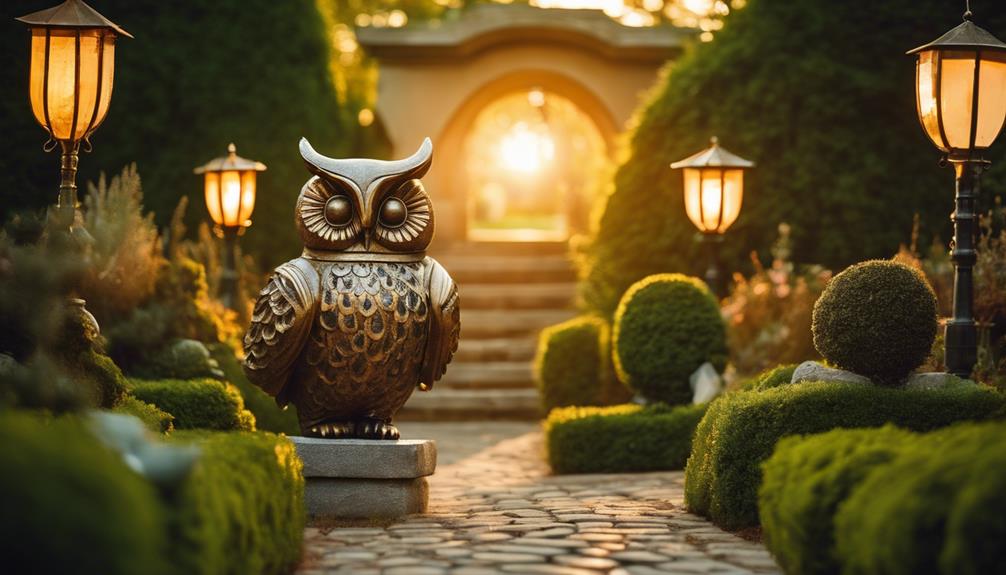
With nature-inspired topiary creations, you can bring a touch of whimsy and playfulness to your garden by mimicking natural elements like animals, birds, or geometric shapes. These unique designs add a charming focal point to your outdoor space, creating a sense of personality and style. By incorporating natural elements, you can create a cohesive look that complements your garden's theme and style.
| Nature-Inspired Design | Description |
|---|---|
| Animal Shapes | Rabbits, birds, and elephants bring a playful touch to your garden |
| Geometric Shapes | Spheres and cones add a modern, artistic flair |
| Cloud Pruning | Soft, cloud-like shapes create a whimsical atmosphere |
When incorporating nature-inspired topiary creations into your garden, consider the theme and style you want to achieve. By customizing your topiary design, you can enhance the visual appeal of your outdoor space, creating a unique and alluring atmosphere. With cloud pruning techniques, you can create soft, cloud-like shapes that add a touch of whimsy to your garden.
Cloud Pruned Topiary Magic
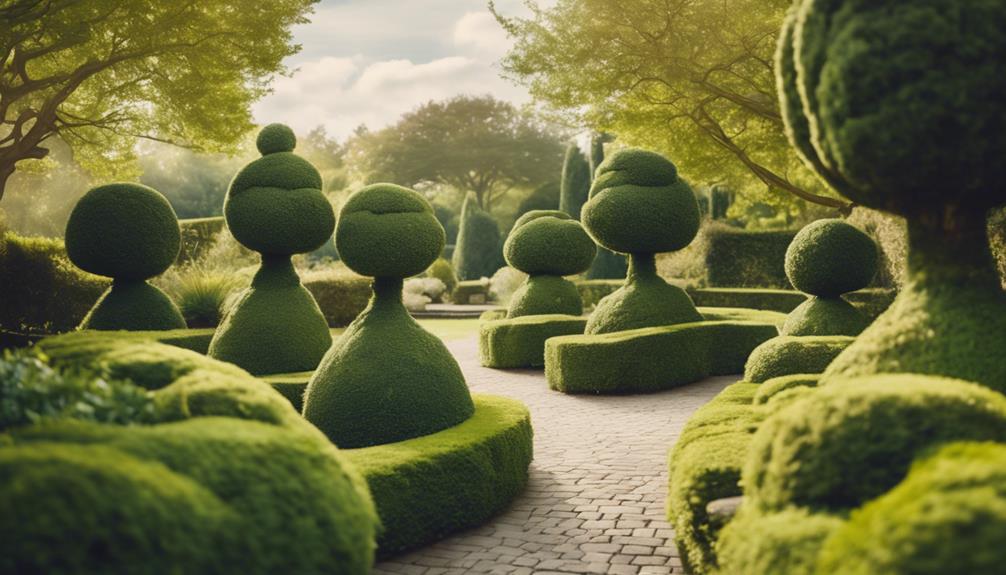
Taking your topiary design to new heights, cloud pruning introduces an artistic dimension that sets your garden apart. This specialized technique, originating from Japan, transforms shrubs and trees into whimsical, cloud-like forms, adding a unique touch to your outdoor space.
To achieve this unique look, you'll need to master the art of cloud pruning, which requires meticulous pruning using shears to shape the foliage into intricate, organic forms.
Here are some key things to keep in mind when attempting cloud pruning:
- Choose the right shrubs: Boxwood, yew, and holly are popular choices due to their dense foliage and ability to hold intricate shapes.
- Be patient: Cloud pruning requires regular maintenance to maintain the desired shape.
- Use the right tools: High-quality pruning shears are essential for achieving precise cuts.
- Don't be afraid to experiment: Cloud pruning is an art form, and it's okay to try new things and make mistakes.
Topiary Hedge Designs for Beauty
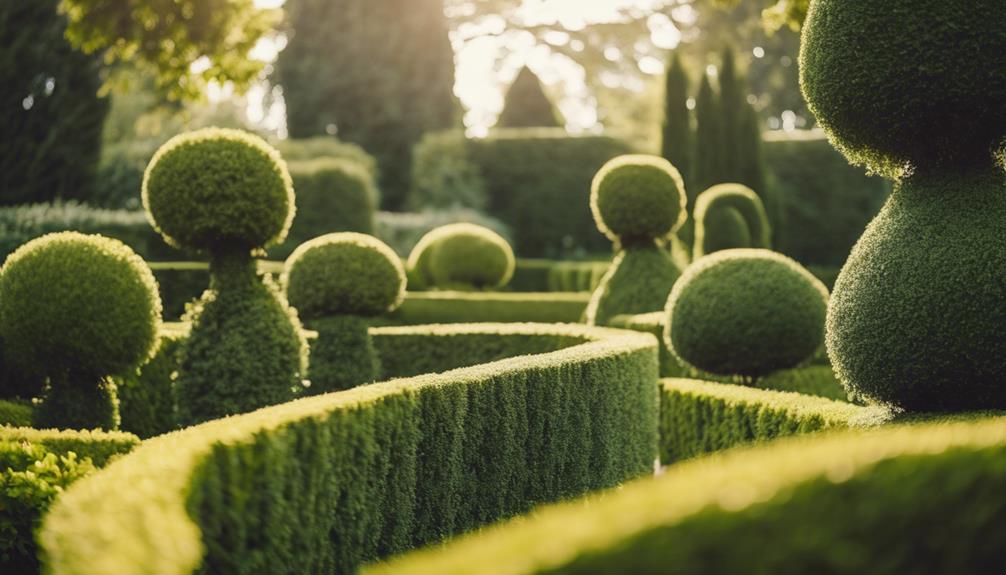
As you explore the world of topiary hedge designs, you'll discover a range of options to enhance your garden's beauty. From classic geometric shapes that add a touch of sophistication to whimsical animal designs that bring a playful vibe, the possibilities are endless.
Next, we'll examine three key points – classic geometric shapes, whimsical animal designs, and formal hedge borders – to inspire your topiary creations.
Classic Geometric Shapes
By incorporating classic geometric shapes, such as spheres, cubes, and cones, into your topiary hedge designs, you can add timeless beauty and elegance to your garden spaces. These shapes provide a sense of structure and organization, creating a formal and balanced look in your garden. Topiary hedges can be sculpted into intricate patterns and designs, adding depth and complexity to your outdoor space.
Some benefits of incorporating classic geometric shapes into your topiary hedge designs include:
- Defining pathways, borders, and outdoor living areas with precision
- Creating a sense of symmetry and balance in the garden
- Adding a touch of elegance and sophistication to your garden spaces
- Providing a versatile design element that can be customized to suit various garden styles
Whimsical Animal Designs
You can add a playful touch to your garden with whimsical animal designs, which transform ordinary topiary hedges into charming creatures that delight the eye and capture the imagination.
These topiary designs, featuring shapes like elephants, peacocks, and rabbits, bring a sense of whimsy and fun to your outdoor space. By using plants like boxwoods, yews, and hollies, you can create a unique and eye-catching focal point in your garden.
To maintain the shape and appearance of your animal topiaries, regular pruning and shaping are essential. With proper care, these whimsical topiary designs can become a stunning accent or centerpiece in your garden, adding a touch of personality and charm to your outdoor space.
Whether you're looking to create a playful atmosphere or simply want to add some visual interest, whimsical animal topiary designs are an excellent choice for garden enthusiasts. By incorporating these creative topiary designs into your garden, you'll be sure to create a truly one-of-a-kind outdoor space that reflects your personal style.
Formal Hedge Borders
Creating a sense of sophistication and refinement, formal hedge borders bring a touch of elegance to your garden, perfectly framing flower beds, walkways, and other landscape features. This classic look is especially suitable for formal gardens, where structure and symmetry are key.
When it comes to creating a formal hedge border, you'll want to choose plants that can be easily shaped and maintained, such as boxwoods or burning bushes.
Some popular options for formal topiary hedges include:
- Clipped yews, which provide a dense, dark green border
- Hornbeams, which can be shaped into neat, rectangular forms
- Boxwoods, which are easy to trim and maintain
- Burning bushes, which offer a vibrant, orange-red color
Winter Interest Topiary Concepts

During the colder months, evergreen shrubs like boxwood and yew can be shaped into stunning topiary forms that maintain a touch of greenery in your winter garden.
You can create visually appealing topiary designs by incorporating shapes like spheres, cones, or spirals, adding structure and visual interest to your winter landscape.
To enhance the appeal of your winter topiary, consider selecting plants with interesting textures and colors, such as variegated boxwoods or golden yews.
Pairing your winter interest topiaries with other seasonal elements, like colorful berries, ornamental grasses, or winter-flowering plants, can create a dynamic and vibrant garden display.
Finally, don't forget to utilize lighting techniques to highlight the sculptural forms of your winter topiary, adding a magical touch to your garden during the darker months.
Unconventional Topiary Shapes
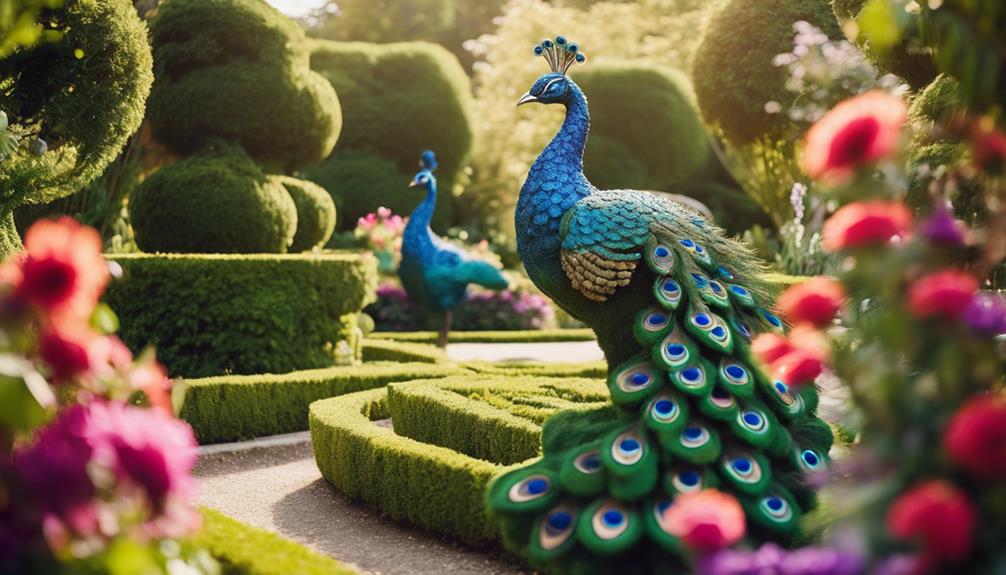
Beyond the classic spheres and cones, unconventional topiary shapes can inject a sense of whimsy and artistry into your garden, inviting visitors to explore and interact with your outdoor space in a more dynamic way. By incorporating unique and creative shapes, you can add a touch of personality to your garden, making it stand out from the crowd.
Some examples of unconventional topiary shapes you might consider include:
- Animals, such as birds, rabbits, or even dragons
- Geometric designs, like spirals, circles, or hexagons
- Whimsical figures, like mythical creatures or abstract forms
- Abstract shapes, like clouds or waves
These unique shapes require skillful pruning and shaping techniques to maintain their intricate forms. However, the result is well worth the effort, as they can create a focal point in your garden and spark conversation among visitors.
Frequently Asked Questions
How Can I Make My Garden Look Amazing?
To make your garden look amazing, you'll want to focus on creating a visually appealing landscape. Start by incorporating structural elements, like pathways and hardscapes, to define different areas of your garden.
Then, add some texture and color with a mix of flowering plants, shrubs, and trees. Don't forget to incorporate a focal point, like a statement piece or a water feature, to draw the eye and create visual interest.
What Plant Makes the Best Topiary?
When choosing a plant for topiary, you'll want one that's easy to shape and maintain.
You might consider plants with small, finely textured leaves like berberis, hebe, or lavender.
Deciduous shrubs like Fagus sylvatica are also great options.
If you're looking for an alternative to boxwood, Japanese holly is a popular choice.
Ultimately, the best plant for topiary is one that's disease-resistant and can tolerate regular pruning.
How to Design a Topiary Garden?
As you step into your garden, envision a symphony of shapes and textures, where nature's beauty is orchestrated by your creative hand.
To design a topiary garden, start by selecting a theme or style that resonates with you. Consider the space's dimensions and choose plants that thrive in your climate.
Next, decide on the shapes you want to create, and use wire frames to guide your pruning.
With patience and practice, your topiary garden will flourish, reflecting your unique vision.
How Do I Make My Garden Aesthetically Pleasing?
To make your garden aesthetically pleasing, you'll want to create a visually appealing landscape. Start by incorporating a mix of plants with varying textures, colors, and growth habits.
Consider adding ornamental elements, like statues or water features, to create focal points.
Don't forget to balance your garden's layout, using symmetry and asymmetry to guide the eye through the space.
Conclusion
With these 10 stunning topiary ideas, you're bound to find inspiration for your garden. Did you know that topiary designs have been around since the 16th century?
In fact, it's estimated that over 75% of British gardens feature some form of topiary. Whether you opt for whimsical woodland designs or modern geometric shapes, topiary can elevate your outdoor space and add a touch of elegance.
From containers to entrance designs, the possibilities are endless, and with these ideas, you'll be well on your way to creating a truly unique garden.
Vivienne – Your Content Companion Vivienne is your content companion, curating valuable tips, advice, and inspiration to guide you on your home decor journey. From insightful blog posts to informative product descriptions, she’s here to empower you with the knowledge you need to create your dream space.
Home Decor
What Are Indonesia’s Sustainable Rural Design Trends?
What are Indonesia’s sustainable rural design trends that integrate traditional knowledge and modern practices, and how do they shape the future of local communities?
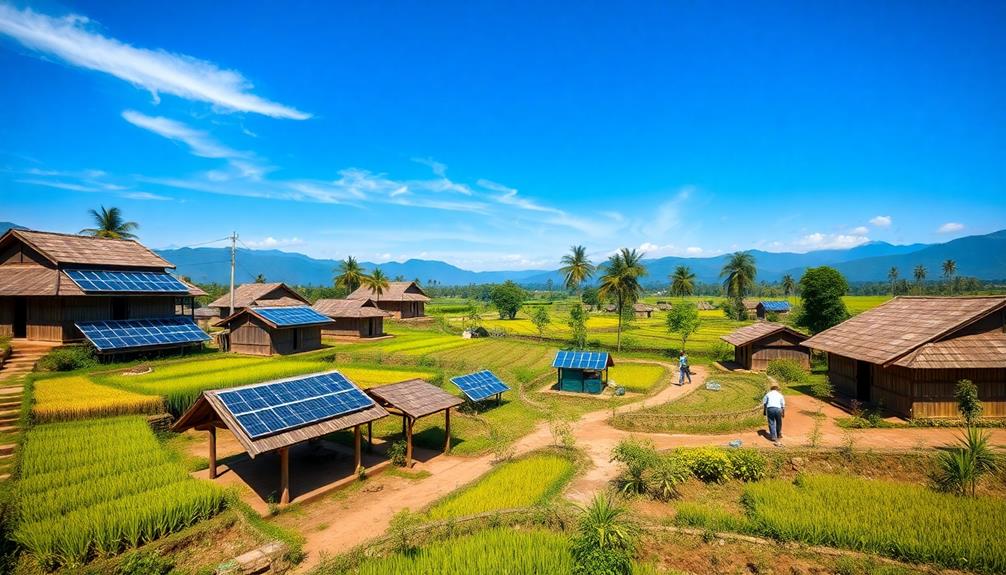
Indonesia's sustainable rural design trends focus on integrating Traditional Ecological Knowledge (TEK) with modern approaches to enhance community resilience. You'll see participatory design methods empowering locals as co-designers, ensuring that their unique needs are met. Initiatives like the Taba Padang village's forest scheme promote sustainable farming while preserving biodiversity. Engagement strategies emphasize collaboration, fostering social innovation and ownership. These trends not only enrich local identity but also improve economic prospects through sustainable practices, like cultivating traditional crops. There's so much more to explore about Indonesia's journey toward sustainability, and these trends are just the beginning.
Key Takeaways
- Integration of Traditional Ecological Knowledge (TEK) enhances sustainable farming practices and aligns agriculture with ecological cycles in rural communities.
- Community-driven initiatives, such as village forest schemes, promote biodiversity and prevent deforestation while improving crop yields.
- Participatory design empowers local residents to co-create sustainable solutions, fostering community engagement and ownership in development projects.
- Ethnographic methods document local cultural practices, ensuring that design outcomes reflect unique community identities and needs.
- Increased market access through improved transportation, like motorbikes, supports economic development and sustainable livelihoods for rural farmers.
Impact of Industrialization and Urbanization
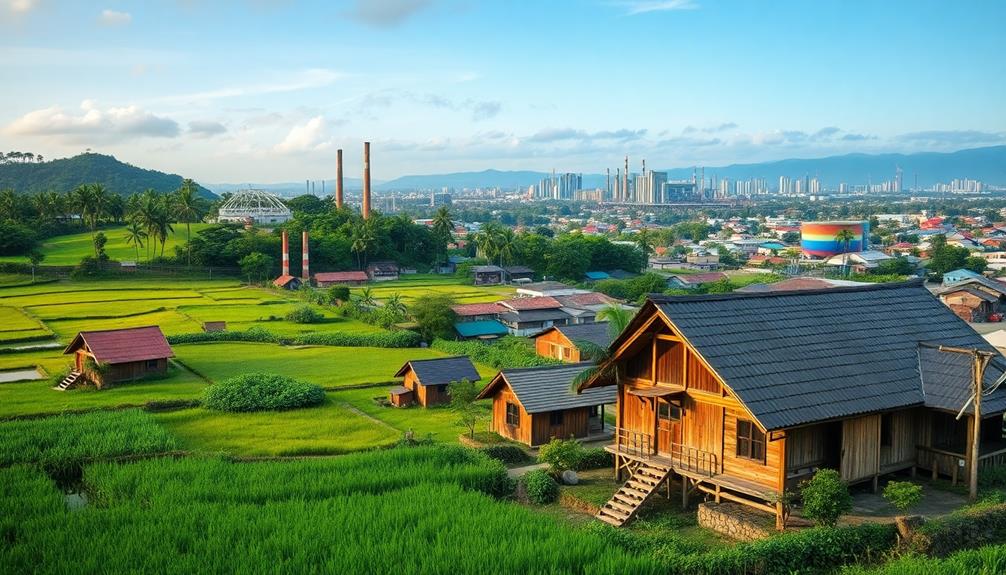
The rapid industrialization and urbanization in Indonesia have profoundly reshaped rural communities and their traditional farming practices. Since the Green Revolution in 1968, mechanized farming techniques have taken root, greatly reducing biodiversity in rural areas.
You may find that the vibrant cultural expressions, such as the Indonesian Decor Mask, are increasingly at risk as these changes take hold. You've likely noticed how urbanization policies have deepened the economic divide, exploiting rural resources and pushing poverty levels higher—12.36% of the rural population faced this challenge as of September 2022.
This shift towards profit-driven, efficient farming hasn't only led to ecological degradation but also eroded cultural practices central to these communities' identities.
As you observe these changes, it's clear that sustainable development is essential for the future of rural Indonesia. Integrating Traditional Ecological Knowledge (TEK) into modern agricultural practices can foster resilience in these communities.
TEK embodies local wisdom and ecological balance, offering invaluable insights that modern methods often overlook. By embracing sustainable design practices that honor these traditions, you can help mitigate the vulnerabilities faced by rural areas, ensuring that their unique cultural heritage and ecological health are preserved.
This approach not only benefits the environment but also strengthens community ties and identity.
Participatory Design and Co-Creation
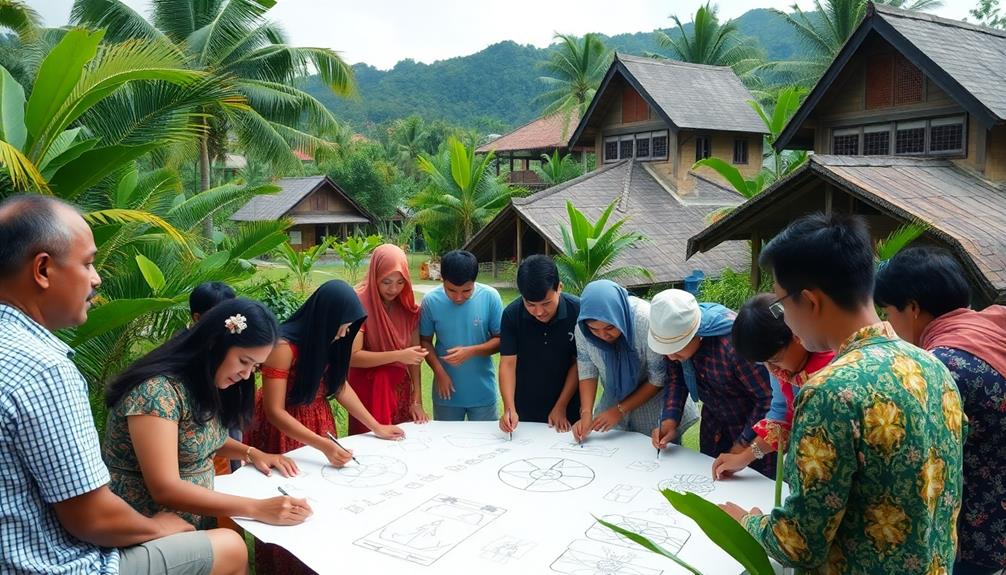
While rural communities in Indonesia face significant challenges from industrialization and urbanization, participatory design and co-creation offer a pathway to empower local residents. This approach emphasizes active involvement, treating community members as co-designers. It fosters social transformation and sustainability by engaging locals in decision-making processes, which is vital as these communities navigate the pressures of modern housing trends and the need for cultural preservation, as seen in the traditional and modern elements of Indonesian housing.
The participatory design process includes five key activities: initiation meetings, treasure mapping, idea generation, craft design workshops, and project reflection. These activities guarantee that everyone's voice is heard, allowing you to contribute to the outcomes that affect your life. Ethnographic methods document local perspectives and cultural activities, reflecting the unique needs and identities of your community.
Co-creation of knowledge enhances local narratives, empowering you and your neighbors to make collective decisions. By integrating Traditional Ecological Knowledge (TEK) into participatory design practices, you strengthen community empowerment and environmental stewardship.
This connection fosters a deeper understanding of sustainable practices that benefit both your community and the environment.
Role of Traditional Ecological Knowledge

Harnessing Traditional Ecological Knowledge (TEK) in Indonesia reveals the invaluable insights local communities possess about their environment and sustainable practices. TEK emphasizes local wisdom, like Niteni, which encourages observing natural phenomena to guide sustainable farming activities.
This approach mirrors the principles found in traditional Indonesian housing, where local materials and ecological awareness shape building practices. By applying the Pranatamangsa system, farmers align their agricultural practices with ecological cycles, enhancing their yields while ensuring sustainability.
Incorporating TEK into modern participatory design practices not only enriches community identity but also fosters pride, driving local engagement in sustainable development initiatives.
This approach promotes environmental stewardship by preserving traditional crop varieties and agricultural methods that are more resilient to climate change.
Community Engagement Strategies

Building on the foundation of Traditional Ecological Knowledge (TEK), community engagement strategies in Indonesia focus on involving local residents as active participants in the design process. This participatory approach encourages you to become a co-designer, fostering social innovation and sustainable development within your community.
For instance, incorporating elements of Indonesian Decorative Pillows can enhance living spaces while reflecting local culture and craftsmanship. In places like Sabrang Village, ethnographic methods help document local cultural practices, ensuring your perspectives and identities shape the design outcomes.
Collaborative workshops bring together local community members and external stakeholders—58 participants in total—to enhance engagement and ownership in development projects. By integrating TEK into these practices, you empower your community with local wisdom and sustainable agricultural methods that promote environmental stewardship.
Moreover, the co-creation of knowledge through participatory learning enriches local narratives, allowing you and your neighbors to collectively tackle challenges and support sustainable regional development.
Case Studies of Sustainable Practices
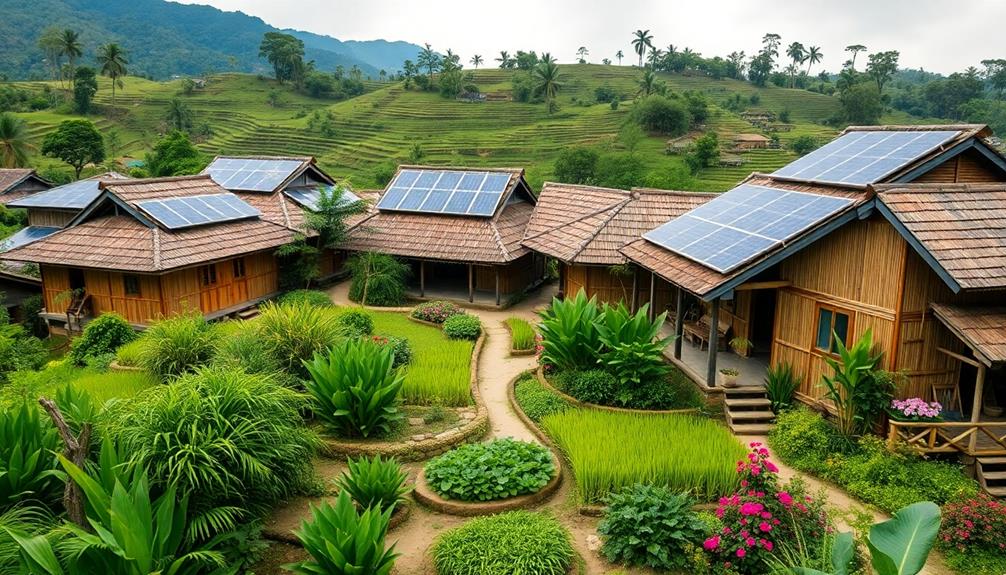
Sustainable practices in Indonesia showcase the transformative power of community-driven initiatives, especially in rural areas. Take Taba Padang village in southwest Sumatra, for example. Here, 470 households have embraced a village forest scheme, managing 1.5 hectares each in a protected forest. This approach promotes sustainable crop growth while preventing deforestation, allowing for the incorporation of local cultural elements into the farming practices, such as traditional planting techniques and community celebrations.
As a result, the community has seen increased incomes from cultivating coffee, pepper, durian, and rattan, which can be further enhanced through events that highlight their unique agricultural products Indonesian Party Decorations.
The introduction of motorbikes for harvest transportation has further improved farming operations, enhancing access to markets and making it easier for farmers to sell their products. Taba Padang's commitment to environmental conservation is evident in their shift from deforestation to reforestation. Regular inspections guarantee everyone adheres to sustainable practices, fostering a sense of responsibility within the community.
Recognized by the Indonesian Ministry of Environment and Forestry, Taba Padang's achievements highlight the potential for eco-tourism, thanks to its natural attractions like waterfalls and hot springs. This case study exemplifies how rural communities can thrive sustainably while protecting the environment, serving as a model for others looking to implement similar practices.
Frequently Asked Questions
What Are the Sustainability Plans of Indonesia?
Indonesia's sustainability plans focus on integrating smart village concepts and renewable energy projects. You'll see initiatives like the Emission Trading Scheme and carbon trading platforms aimed at enhancing community resilience and promoting environmental responsibility.
Why Are Rural Areas More Sustainable?
Imagine a thriving garden, where every plant shares its resources. In rural areas, community ties and traditional knowledge foster sustainability, allowing you to nurture the land and its diversity while ensuring a balanced, harmonious existence.
Conclusion
In Indonesia, the convergence of industrialization and a deep-rooted respect for traditional ecological knowledge creates a unique landscape for sustainable rural design. By embracing participatory design and community engagement, you're not just witnessing a trend; you're part of a transformative movement. Coincidentally, as rural areas adapt to modern challenges, they also revive age-old practices, illustrating that sustainability isn't merely a goal but a harmonious blend of past wisdom and present innovation, shaping a brighter future for all.
Home Decor
Emerging Sustainable Trends in Rural Design
Get ready to discover how innovative sustainable trends in rural design are transforming communities, but what groundbreaking practices are leading the way?
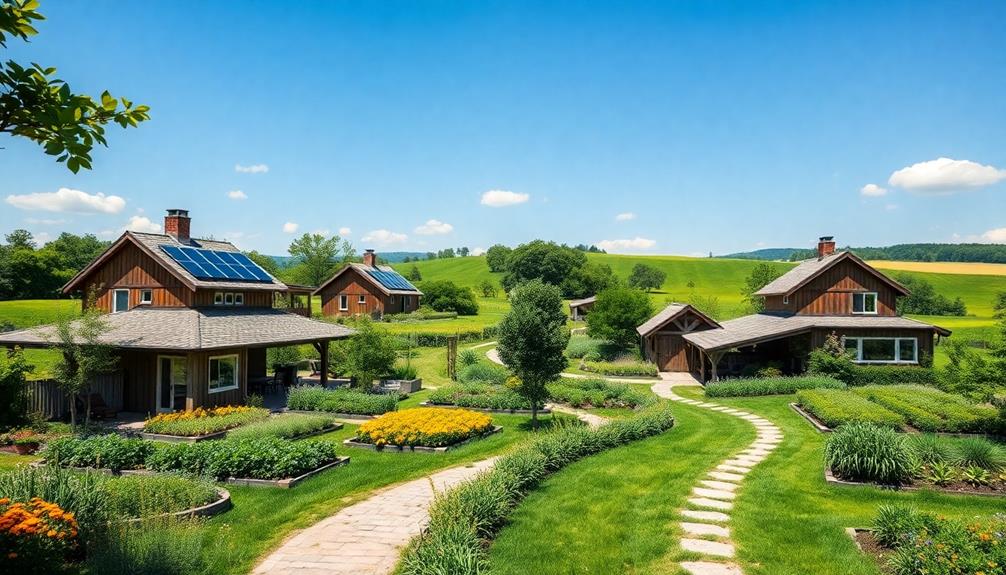
Emerging sustainable trends in rural design focus on eco-friendly practices that promote community resilience and environmental health. By integrating renewable energy solutions like solar panels, you enhance energy independence while reducing costs. Using local, natural materials supports economies and minimizes transportation emissions. Implementing water conservation techniques addresses resource scarcity effectively. Community-centric planning guarantees developments meet local needs and values, fostering social cohesion. Innovations in agriculture, such as precision farming, improve yields and sustainability. These trends not only uplift local economies but also enhance well-being. Keep exploring to uncover even more transformative practices reshaping rural landscapes today.
Key Takeaways
- Sustainable rural design emphasizes renewable energy integration, enhancing energy independence and reducing reliance on non-renewable sources.
- Community-centric planning practices ensure developments resonate with local needs and values, fostering social cohesion and quality of life.
- Nature-inspired design approaches enhance aesthetics and sustainability through passive solar design, green spaces, and local materials.
- Resource efficiency strategies, such as rainwater harvesting and locally sourced materials, significantly reduce waste and operational costs.
- Innovations in agriculture and renewable energy, like organic farming and micro-hydroelectric systems, boost local economies and promote ecological balance.
Overview of Sustainable Rural Design
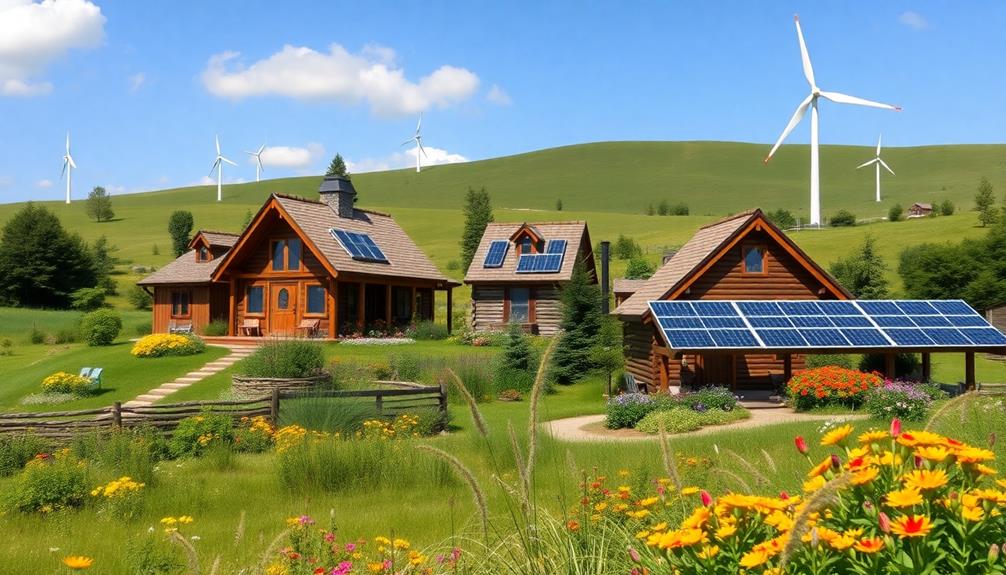
Sustainable rural design is increasingly becoming essential for creating resilient communities that thrive while respecting the environment. By integrating renewable energy solutions like solar panels and wind turbines, you can enhance energy independence in rural areas. These sources not only reduce reliance on fossil fuels but also lower energy costs over time.
Incorporating natural materials, similar to Balinese design characteristics, can further enhance sustainability and create a warm, inviting atmosphere. Using locally sourced materials such as compressed earth blocks can greatly reduce construction expenses while supporting local economies. This approach promotes sustainable living practices that benefit both the community and the environment.
Additionally, implementing water conservation techniques, including rainwater harvesting and greywater recycling, addresses pressing water scarcity issues effectively. Incorporating biophilic design principles into rural structures fosters a connection with nature, enhancing the well-being of occupants through green spaces and natural light.
You'll find that innovative housing solutions, like modular homes, offer cost-effective and energy-efficient options. These designs minimize construction waste and time while promoting eco-friendly practices.
Key Principles of Ecological Design
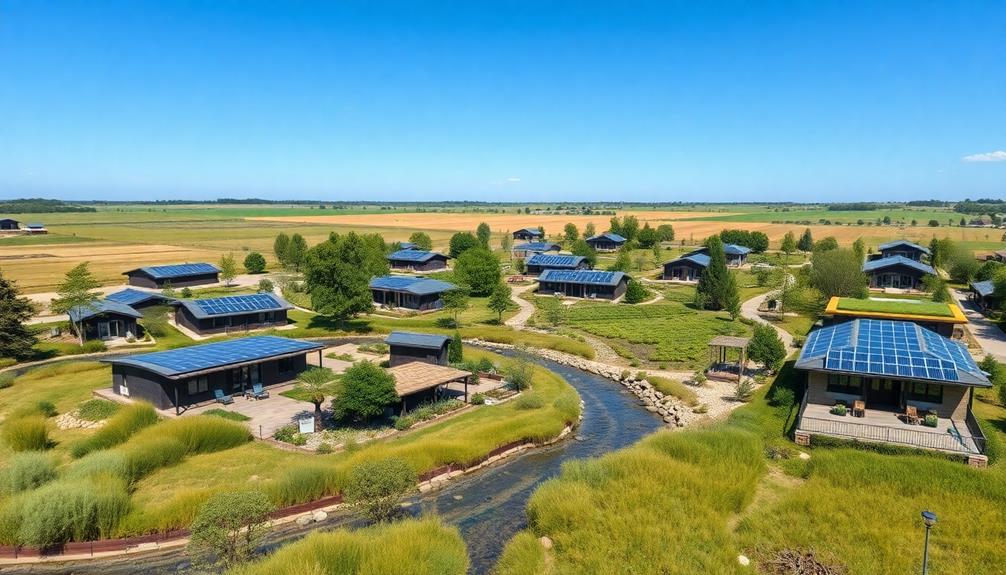
When you think about ecological design, consider how nature-inspired approaches can shape your projects.
Emphasizing harmony with nature, as seen in traditional Indonesian style home decor, can enhance the aesthetic while promoting sustainability.
You'll want to focus on resource efficiency strategies that minimize waste and maximize sustainability.
Plus, incorporating community-centric planning practices guarantees that your designs truly reflect the needs and values of the people living in those spaces.
Nature-Inspired Design Approaches
Embracing nature-inspired design approaches can transform rural architecture into vibrant, sustainable spaces that harmonize with their surroundings. By prioritizing biomimicry, you can emulate natural forms and processes, creating efficient structures that work seamlessly with ecosystems.
These sustainable architecture practices often utilize local materials and traditional building techniques, such as those found in traditional Indonesian housing, which reduce carbon footprints and celebrate cultural heritage.
Key elements of nature-inspired design include:
- Passive solar design: Optimize building orientation and thermal mass to cut energy consumption.
- Ecological design: Integrate green spaces and native landscaping to enhance biodiversity and improve air quality.
- Water management strategies: Implement natural ponds and rain gardens for effective water conservation.
- Local materials: Use materials sourced from nearby to minimize transportation emissions.
- Wildlife habitats: Create environments that support local fauna, promoting ecological balance.
Resource Efficiency Strategies
Resource efficiency strategies play a pivotal role in ecological design, building on the foundation of nature-inspired approaches. By prioritizing locally sourced materials, you can greatly reduce transportation emissions while supporting local economies.
For example, incorporating elements from traditional Indonesian wedding decor ideas can enhance community connections through locally sourced floral arrangements and handcrafted decor. Take, for instance, the rising popularity of compressed earth blocks and bamboo construction—these options embody sustainable choices.
Implementing rainwater harvesting systems and greywater recycling is another effective strategy. You could reduce water consumption by up to 50%, promoting sustainable water use in your community.
Furthermore, integrating renewable energy sources like solar panels and small wind turbines not only enhances energy independence but can also cut household energy costs by 30-50%.
Utilizing passive solar design techniques, such as strategic building orientation and thermal mass, helps you maximize natural heating and cooling, potentially reducing energy use for temperature regulation by 20-40%.
Additionally, embracing eco-friendly product designs, like low-cost cooking stoves and efficient irrigation systems, can lower resource consumption and operational costs.
These strategies collectively improve the quality of life for rural residents, making your community more sustainable and resilient in the long run.
Community-Centric Planning Practices
Community-centric planning practices are essential for fostering sustainable rural development that truly reflects the needs and values of local residents. By prioritizing community engagement and participatory design, you can guarantee that developments resonate with the people who'll use them.
Significantly, traditional Indonesian houses, such as Rumah Adat, emphasize community-oriented layouts that encourage social interaction and a sense of belonging. Studies have shown that this approach can lead to a 30% increase in community satisfaction.
Utilizing ecological design principles, such as:
- Incorporating local materials to reduce emissions and costs
- Designing green spaces that boost social cohesion and safety
- Integrating renewable energy solutions for economic resilience
- Promoting sustainable agricultural practices to enhance biodiversity
- Creating shared public areas that foster community interaction
These strategies not only support economic development but also enhance the quality of life in rural areas.
For instance, using compressed earth blocks can cut construction costs by 20%, while renewable energy solutions can reduce energy costs by 50%. By focusing on sustainable practices, you can create vibrant, thriving communities that prioritize both ecological health and resident well-being.
Embracing these community-centric approaches guarantees a holistic development model that benefits both people and the planet.
Community-Centric Planning Approaches
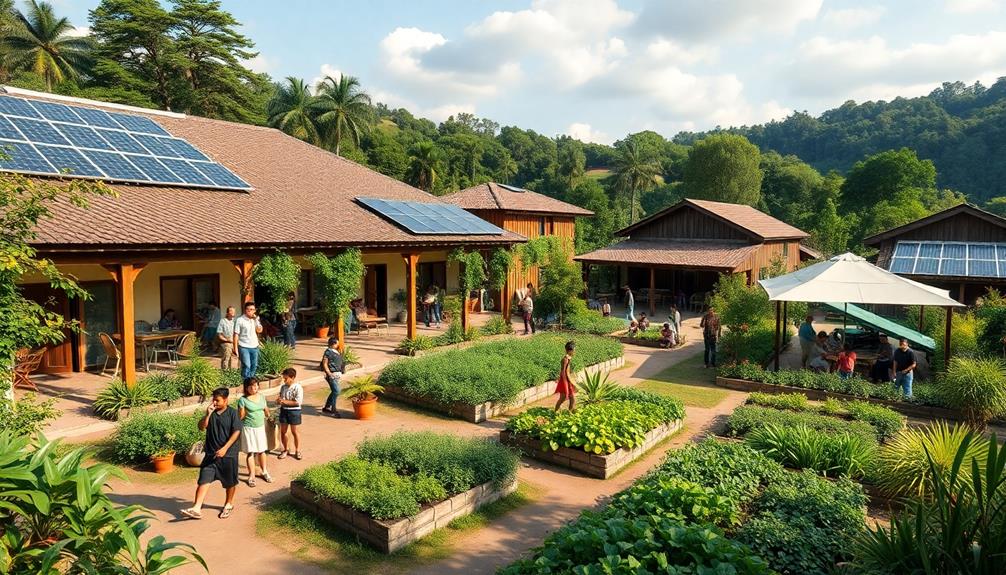
When you embrace participatory design methods, you empower your community to shape its own future.
Incorporating elements of local culture, such as Indonesian Decorative Pillows, can enhance the sense of identity and belonging among residents.
Engaging local residents not only enhances their connection to the area but also guarantees that developments truly reflect their needs and values.
Participatory Design Methods
Participatory design methods empower residents to take an active role in shaping their environment, guaranteeing that projects align with local needs and values. By engaging community members in the planning process, you foster a sense of community ownership and pride.
This approach can also reflect local craftsmanship, similar to how the intricate designs of Indonesian decor masks enhance cultural appreciation in various settings. Studies show that projects that involve local input are 30% more likely to be accepted and utilized, creating sustainable solutions that truly reflect the community's unique characteristics.
Here are some key aspects of participatory design:
- Inclusivity: Engaging diverse backgrounds guarantees all voices are heard.
- Workshops: Collaborative sessions allow community members to share their ideas.
- Cultural relevance: Designs become contextually appropriate, reflecting local traditions.
- Social cohesion: Strengthening relationships among residents improves overall quality of life.
- Empowerment: Community members gain confidence in their ability to influence change.
Enhancing Local Engagement
Engaging local residents in the planning process not only builds on the principles of participatory design but also fosters a deeper connection to the projects that shape their environment.
When you prioritize community input, you guarantee developments reflect local traditions and values, enhancing inclusivity. This approach cultivates a sense of ownership, making residents more likely to embrace and utilize community projects.
By integrating elements of tropical architecture that resonate with local culture, such as open spaces and natural light, you can further enhance the sense of belonging within the community.
Involving diverse stakeholders, including marginalized groups, promotes social cohesion and addresses historical disparities in rural development.
By integrating local knowledge, you're more likely to identify unique environmental and social considerations that standard practices might overlook, leading to sustainable outcomes.
Moreover, successful community engagement has been linked to improved mental health and well-being.
When you strengthen social networks and create spaces that encourage interaction, you support community activities that enhance overall quality of life.
Innovations in Renewable Energy
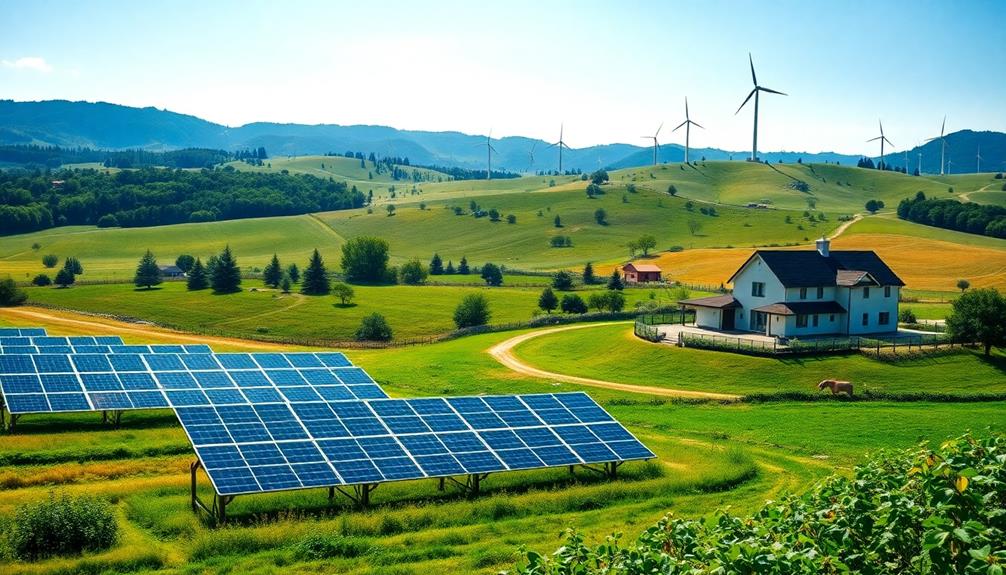
Rural areas are witnessing a surge in renewable energy innovations that are transforming how communities power their lives. By investing in sustainable energy sources, you can enhance energy independence and greatly reduce greenhouse gas emissions.
For instance, solar energy is projected to account for about 20% of global electricity generation by 2040, making it a key player in rural energy strategies. The emphasis on sustainable craftsmanship in Balinese furniture also reflects a growing trend towards eco-friendly practices in various sectors.
Consider the benefits of these innovations:
- Micro-hydroelectric systems: Harness flowing water to create decentralized energy solutions, cutting costs by up to 30%.
- Solar-powered irrigation systems: Boost agricultural efficiency, potentially increasing crop yields by 20-30%.
- Wind energy projects: Provide reliable power while supporting local job opportunities in the renewable energy sector.
- Energy independence: Reduces reliance on non-renewable sources, allowing rural communities to thrive sustainably.
- Economic growth: The renewable energy sector is expected to create over 24 million jobs globally by 2030.
Sustainable Agriculture Practices

Sustainable agriculture practices are revolutionizing how we produce food while minimizing environmental impact. By focusing on efficient resource management and innovative techniques, these practices not only enhance food production but also promote biodiversity conservation. You can see how various methods contribute to sustainable food sources in the table below:
| Practice | Benefits |
|---|---|
| Organic Farming | Reduces chemical use |
| Precision Farming | Increases crop yields by 20-30% |
| Agroecological Practices | Enhances ecosystem health |
| Water Management Innovations | Cuts water usage by up to 30% |
| Local Seasonal Production | Supports food security in rural communities |
Adopting these sustainable agriculture practices addresses critical challenges, including water scarcity and the need for food security. By emphasizing local food production, you can strengthen rural economies and foster community resilience. As the organic farming market is projected to reach $500 billion by 2025, it's clear that the shift toward sustainability is not just beneficial but essential for our future. Embrace these practices to help create a more sustainable world.
Enhancing Local Economies
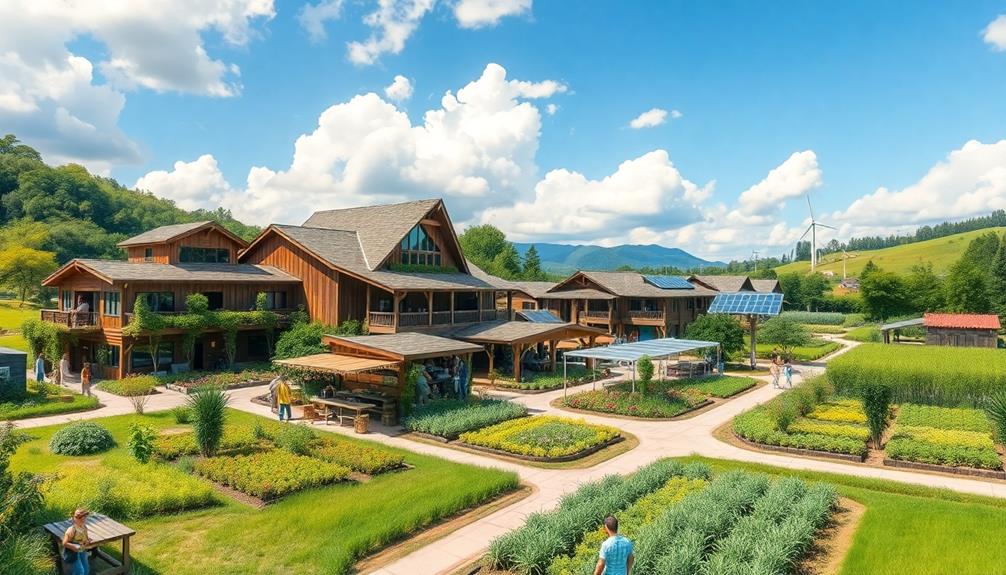
Investing in sustainable agriculture practices not only boosts food production but also lays the groundwork for enhancing local economies. By focusing on rural development, you're supporting initiatives that contribute around 30% to global GDP.
Additionally, incorporating elements of traditional artistry, such as Indonesian decor masks, can celebrate local culture and attract tourism, further promoting economic growth. This investment fosters economic growth and diversifies income sources, as non-farm activities now account for up to 50% of rural income in some areas.
Consider the following strategies to enhance local economies:
- Support renewable energy projects that create jobs and reduce dependency on non-renewable sources.
- Encourage sustainable entrepreneurship by providing training and resources for local business owners.
- Promote infrastructure investment, such as improved transportation networks, to enhance market access for local products.
- Expand access to financial services, including microfinance options, to empower entrepreneurs and stimulate economic development.
- Develop community programs that foster collaboration and knowledge-sharing among local businesses.
These sustainable practices not only improve the quality of life in rural areas but also create a robust ecosystem that drives long-term economic stability.
Health and Well-being in Design
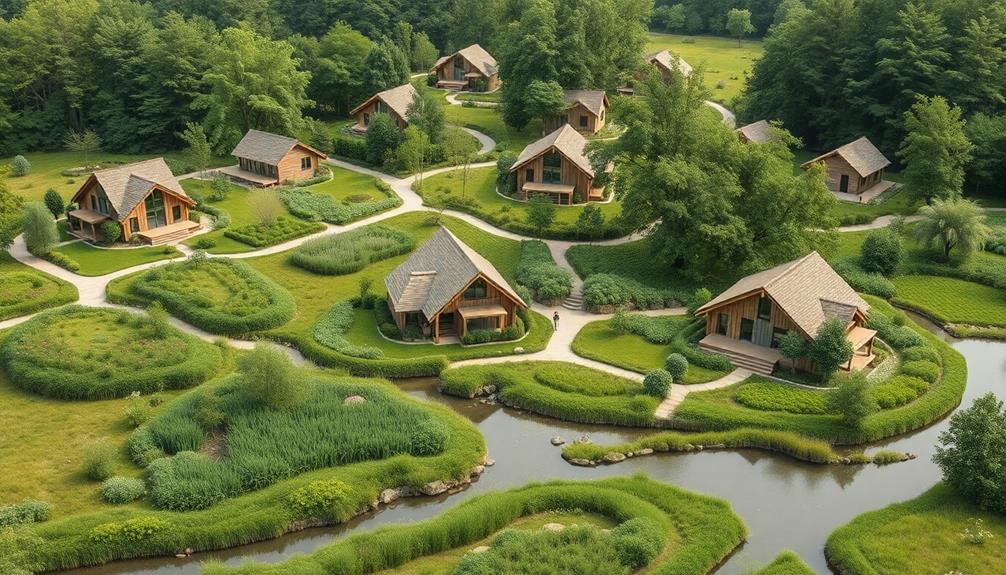
There's a growing recognition that the design of our living spaces greatly impacts health and well-being. By integrating biophilic design principles, you can create environments that foster mental well-being and reduce stress. Access to green spaces not only enhances air quality but also encourages physical activity, leading to improved physical health outcomes.
Natural light and proper ventilation are essential in rural homes, enhancing indoor comfort and productivity. Additionally, using eco-friendly materials minimizes indoor air pollutants, creating a healthier living environment. Community engagement is significant as it helps foster social connections, enhancing a sense of belonging that is fundamental for mental health.
Here's a quick summary of these key aspects:
| Design Element | Benefits |
|---|---|
| Biophilic Design | Reduces stress, boosts mental well-being |
| Access to Green Spaces | Improves air quality, enhances physical health |
| Natural Light | Increases comfort and productivity |
| Eco-Friendly Materials | Lowers indoor pollutants for healthier living |
Incorporating these elements not only promotes individual well-being but also strengthens community ties, ultimately leading to a healthier rural lifestyle.
Future Directions for Rural Development
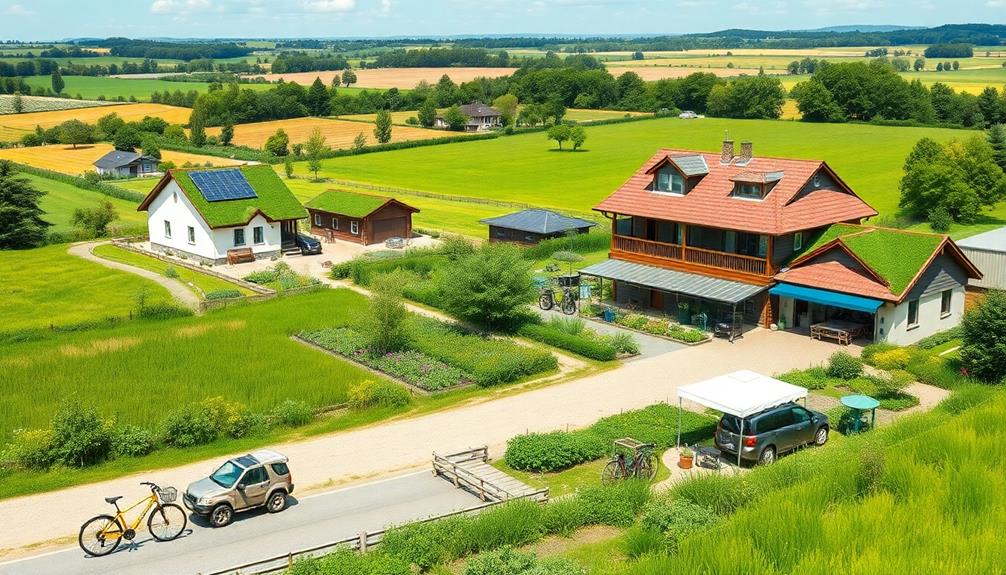
As rural development evolves, a clear focus on sustainable agriculture practices will shape the future landscape of these communities.
You'll see an increasing emphasis on innovative solutions that enhance food security and drive economic growth. The organic farming market, projected to reach $500 billion by 2025, is just one example of how sustainable development can transform rural areas.
Consider these key trends that will define future rural development:
- Investment in infrastructure: Improved transportation and utilities will create better access to markets.
- Precision farming technologies: These advancements promise to boost crop yields by 20-30%, optimizing natural resources.
- Rural entrepreneurship: Non-farm activities can contribute up to 50% of rural income, fostering innovation and job creation.
- Energy efficiency initiatives: Adopting eco-friendly living practices will reduce waste and enhance sustainability.
- Access to education: Educational programs will empower residents, equipping them with skills for new employment opportunities.
As you engage with these developments, you'll witness a more resilient and sustainable future for rural communities, ultimately leading to a thriving, eco-friendly lifestyle.
Frequently Asked Questions
What Are the Examples of Sustainable Development in Rural Areas?
You'll find examples of sustainable development in rural areas like renewable energy projects, organic farming, eco-friendly modular housing, community-driven design, and innovative water management systems, all enhancing local independence, efficiency, and environmental conservation.
How to Promote Sustainability in Rural Areas?
Imagine a future where your community thrives—by adopting renewable energy, sustainable agriculture, eco-friendly housing, and efficient water management. You can engage locals, ensuring their needs shape projects, fostering lasting change and shared ownership of a sustainable tomorrow.
What Are the Sustainable Development Goals of Rural Development?
The sustainable development goals for rural development focus on eradicating poverty, ensuring food security, managing water resources, promoting economic growth, and enhancing urban-rural connections. You'll play a key role in achieving these goals through local initiatives.
What Are the Challenges of Rural Sustainability?
Rural regions wrestle with resource restraints, aging populations, and climate changes. You'll face fragmented infrastructure and limited community involvement, making it tough to tackle sustainability challenges effectively and foster vibrant, resilient rural futures.
Conclusion
As you embrace these emerging sustainable trends in rural design, you'll cultivate greener landscapes, nurture stronger communities, and inspire healthier lifestyles. By prioritizing ecological principles, harnessing renewable energy, and supporting local economies, you'll create vibrant spaces that thrive today and tomorrow. Picture thriving farms, bustling markets, and interconnected neighborhoods, all blossoming under the sun of sustainability. Together, let's pave the way for a brighter, more resilient rural future, where nature and community flourish hand in hand.
Home Decor
Sustainable Rural Design Trends Shaping Indonesia
Uncover how sustainable rural design trends in Indonesia are transforming communities and preserving cultural heritage, creating a brighter future for its residents.
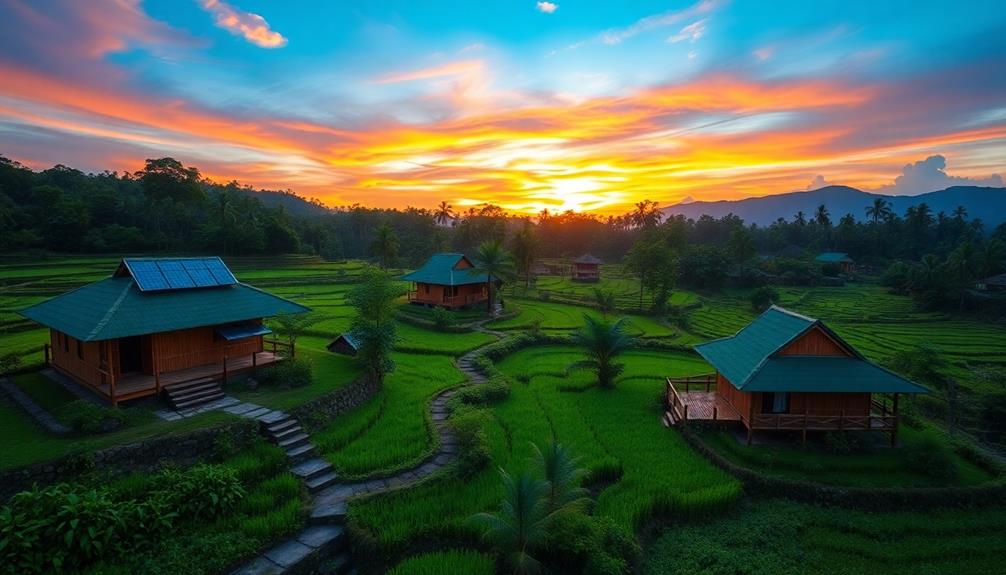
In Indonesia, sustainable rural design trends are transforming communities while respecting cultural heritage. You'll see a strong focus on participatory design, where locals co-create their environments, empowering them and preserving their identities. Traditional Ecological Knowledge plays a crucial role, guiding farming practices and promoting ecological balance. This approach not only fosters local pride but also boosts sustainable tourism, which generates economic benefits. Areas like Sabrang Village illustrate these principles, combining natural materials and local craftsmanship. Discover how these trends are shaping the future of rural Indonesia and enhancing the lives of its residents.
Key Takeaways
- Participatory design engages local residents as co-designers, fostering community identity and ensuring designs meet local needs.
- Traditional ecological knowledge (TEK) enhances sustainability and preserves regional identity through culturally rooted practices and natural observations.
- Case studies like Sabrang Village demonstrate successful integration of traditional craftsmanship and modern design principles for economic growth and community involvement.
- Sustainable tourism initiatives leverage cultural heritage, attracting visitors while boosting local economies and promoting environmental conservation.
- Emphasizing community engagement and ecological balance is crucial for revitalizing rural areas and addressing the impacts of industrialization.
Impact of Industrialization on Rural Areas

Industrialization has drastically altered the landscape of rural Indonesia, impacting both livelihoods and cultural traditions. You've likely noticed how mechanized farming methods have replaced traditional agricultural practices, leading to a significant loss of local biodiversity since the Green Revolution in 1968. This shift not only threatens the ecological balance but also diminishes the rich cultural practices tied to farming communities.
Traditional Indonesian housing, often designed to reflect the local environment and cultural values, is also at risk as modernization takes hold, with many communities losing their architectural heritage as a result of urbanization and economic pressures traditional homes and cultural symbolism.
Urbanization policies have exacerbated economic disparities, leaving rural areas struggling. With a rural poverty rate of 12.36% as of September 2022, many rural communities face increasing unemployment and school dropout rates. The focus on profit and efficiency in modern agriculture often neglects the needs of these communities, fueling social change that further isolates them from their cultural roots.
In this landscape, the necessity for sustainable development becomes clear. Supporting design practices that honor traditional methods while promoting ecological balance is essential for revitalizing rural areas. By fostering community engagement and sustainable practices, you can help bridge the gap between industrialization and the preservation of Indonesia's rich cultural heritage, creating a more equitable future for rural communities.
Participatory Design in Community Development
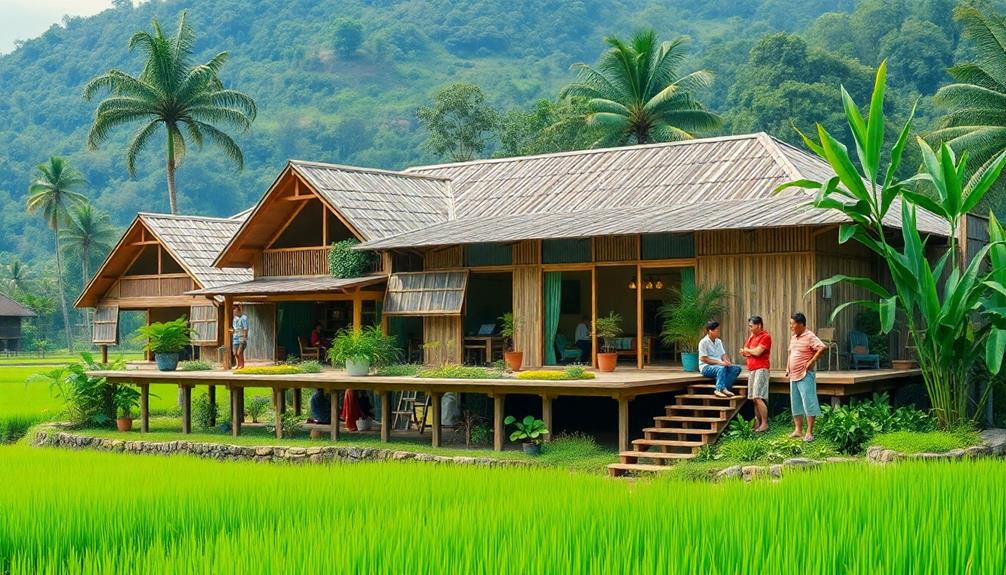
Participatory design transforms community development by actively engaging local residents as co-designers in the process. This approach empowers you and your neighbors, enhancing local narratives and identities while fostering collective decision-making.
By incorporating elements of Indonesian decorative pillows into community spaces, designs can reflect cultural heritage and enhance aesthetics. Through a structured process that includes initiation meetings, treasure mapping, idea generation, craft design workshops, and project reflection, participatory design guarantees thorough community engagement.
Employing ethnographic methods allows for a deep understanding of your community's life and cultural activities, resulting in designs that truly reflect local perspectives and needs. By involving you and your fellow community members in experiential learning, this method supports social innovation and sustainable development, addressing both human and ecological needs.
A recent project showcased the power of diverse collaboration, with 58 participants, including 24 local community members and 28 external stakeholders. This highlights the importance of engaging all voices in the community.
Ultimately, participatory design not only builds a sense of ownership among residents but also leads to solutions that are more viable and relevant. As you participate, you're not just contributing to a project; you're helping shape the future of your community.
Role of Traditional Ecological Knowledge
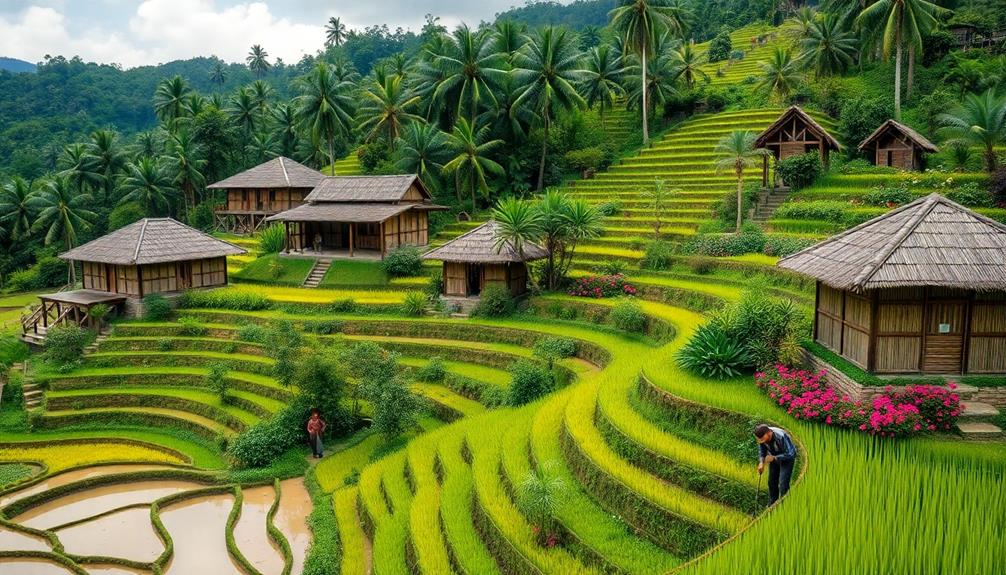
Harnessing the wisdom of Traditional Ecological Knowledge (TEK) is essential for achieving sustainable development in Indonesia. TEK reflects local cultural practices that promote ecological balance and sustainability. By observing natural phenomena through Niteni, farmers adapt their agricultural activities based on seasonal guidelines, enhancing yields while respecting the environment.
| TEK Element | Impact | Community Benefit |
|---|---|---|
| Seasonal Guidelines | Aligns farming with cycles | Increases agricultural resilience |
| Heritage Preservation | Maintains regional identity | Fosters local pride |
| Sustainable Tourism | Promotes eco-friendly travel | Boosts local economy |
Incorporating TEK into participatory design practices empowers communities and strengthens local wisdom. This co-creation of knowledge respects cultural identities and enhances regional development. By integrating these practices, you not only support sustainable tourism initiatives but also create a foundation for long-term ecological stewardship. Embracing TEK is a powerful way to guarantee that Indonesia's rich heritage thrives alongside modern advancements, creating a harmonious future for both the environment and its people.
Social Design and Community Engagement
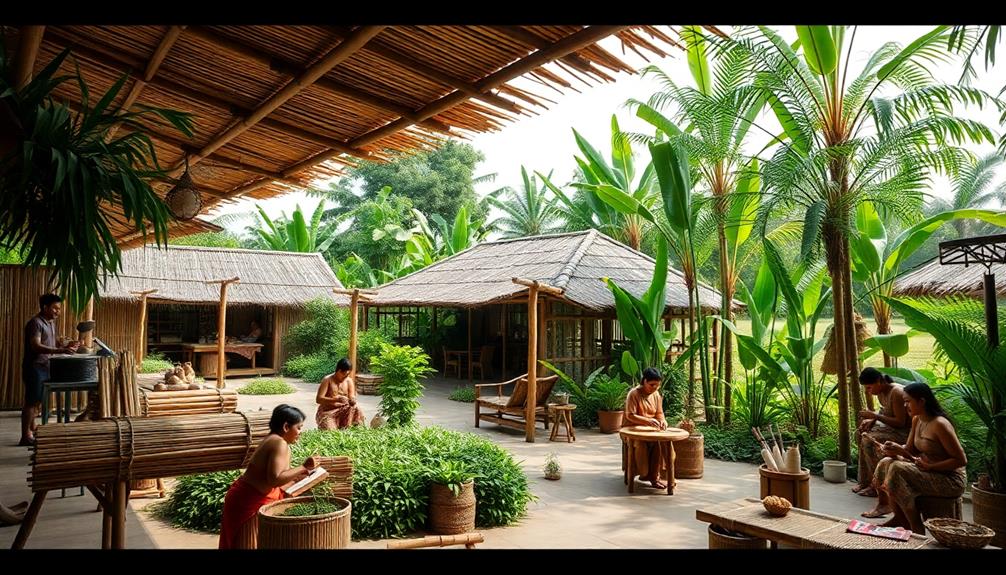
Building on the foundation laid by Traditional Ecological Knowledge, social design plays an essential role in fostering community engagement in rural Indonesia. This approach emphasizes openness and connectedness, driving social innovation and inspiring local communities to collaborate effectively.
By employing participatory design, you actively involve stakeholders, treating them as co-designers. This not only enhances community empowerment but also promotes sustainable regional development. Traditional Indonesian houses, known for their community-oriented layout, further underscore the importance of collaboration and social interaction within these rural settings, reflecting the cultural significance of housing.
Engagement in projects, like one involving 58 participants, highlights how regular consultations with local farmers and government representatives facilitate knowledge exchange and collective decision-making, vital for effective rural development.
Ethnographic methods capture community life and cultural activities, ensuring local perspectives inform design processes and strengthen cultural identity.
Moreover, community engagement through participatory learning encourages experiential knowledge acquisition, equipping residents with the skills necessary for resilience in rural areas.
As you immerse yourself in these processes, you'll realize that social design isn't just about creating structures or systems; it's about empowering communities to shape their environment.
Case Study: Sabrang Village Insights
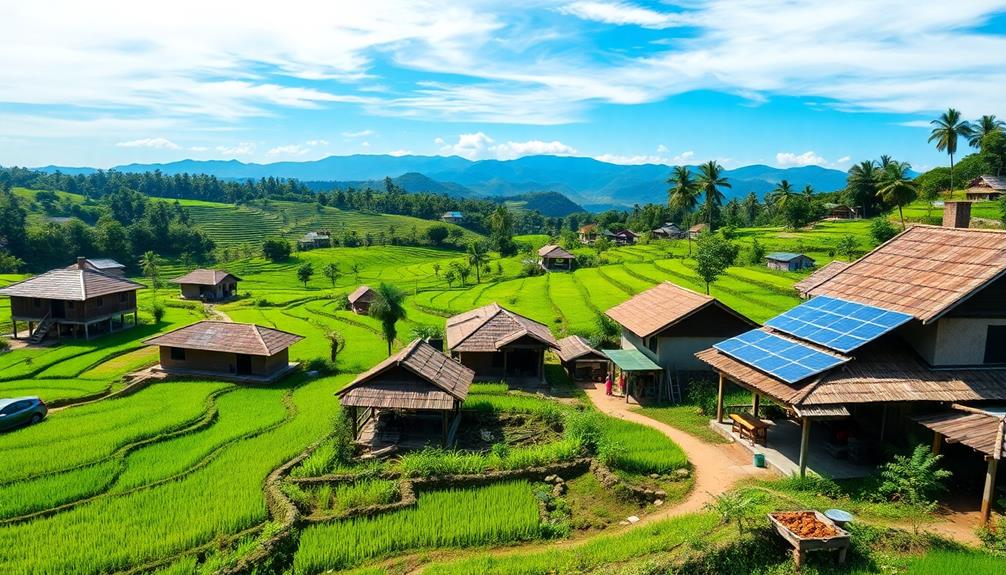
Sabrang Village stands out as a vibrant example of sustainable rural design in Indonesia, where local farmers cultivate rice varieties like Rojolele and Mentik Wangi, producing an impressive 20,395 tons annually.
This thriving community emphasizes sustainable development through identity-making and the integration of local culture into its initiatives. By involving community members as co-designers, Sabrang fosters participatory design that promotes local narratives and collective decision-making.
The emphasis on natural materials and traditional craftsmanship resonates with Balinese design characteristics, enriching the village's identity and sense of place. Traditional ecological knowledge, especially practices like Niteni and Pranatamangsa, plays an essential role in guiding sustainable agricultural practices and preserving local wisdom.
You'll notice how these practices enhance the village's agricultural activities while also reinforcing community bonds. The integration of Japanese design principles further enriches Sabrang's approach, emphasizing bi-directional learning that enhances craftsmanship and community involvement.
This holistic approach not only strengthens Sabrang's economic activities but also highlights its tourism potential. Visitors are drawn to the village's unique blend of tradition and innovation, making it a model for other rural areas aiming for sustainable growth.
In Sabrang, community involvement and respect for local culture create a blueprint for sustainable rural development that other regions can aspire to replicate.
Frequently Asked Questions
What Are the Main Challenges to Sustainable Rural Design in Indonesia?
You'll face challenges like limited resources, inadequate infrastructure, and diverse cultural practices. Balancing economic growth with environmental sustainability is tough, too. Engaging the community and fostering collaboration can help overcome these hurdles effectively.
How Can Technology Support Sustainable Rural Development Efforts?
When it comes to sustainable rural development, technology's your best friend. You can leverage data analytics, renewable energy, and smart agriculture tools to enhance efficiency, reduce waste, and ultimately create a thriving, eco-friendly community.
What Role Do Government Policies Play in Rural Sustainability?
Government policies shape rural sustainability by providing frameworks for funding, resources, and regulations. You'll find that effective policies encourage community engagement, promote eco-friendly practices, and support infrastructure development, driving long-term benefits for rural areas.
How Do Local Cultures Influence Sustainable Design Practices?
Local cultures shape sustainable design practices by embedding traditional knowledge and values into modern approaches. You'll find that community involvement, local materials, and unique customs drive innovative solutions that respect the environment and enhance livability.
What Funding Sources Are Available for Sustainable Rural Projects?
To fund sustainable rural projects, you might explore grants from organizations like the Global Environment Facility. These funds could help implement a community solar initiative, enhancing energy access while promoting eco-friendly practices in your area.
Conclusion
As you explore sustainable rural design trends in Indonesia, you'll find that 80% of the population still lives in rural areas, highlighting the importance of innovative practices. By embracing participatory design and traditional ecological knowledge, communities can thrive amidst industrial pressures. Engaging with locals not only fosters social cohesion but also leads to solutions tailored to their unique contexts. The case of Sabrang Village exemplifies how these approaches can create resilient and vibrant rural spaces for future generations.
-

 Vetted4 months ago
Vetted4 months ago14 Best Personalized Father's Day Gifts for Your Husband – Show Him You Care
-

 Alfresco4 months ago
Alfresco4 months agoAlfresco Stacker Doors: Seamless Indoor-Outdoor Living!
-

 Vetted5 months ago
Vetted5 months ago15 Best EMS Foot Massagers for Neuropathy to Soothe Your Feet
-

 Craft and Textiles6 months ago
Craft and Textiles6 months ago15 Best Places to Buy Appliances for Your Home – Top Retailers Reviewed
-

 Craft and Textiles6 months ago
Craft and Textiles6 months ago15 Best Gifts for 4-Year-Old Girls That Will Spark Joy and Creativity
-

 Craft and Textiles6 months ago
Craft and Textiles6 months ago15 Best Battery-Powered Leaf Blowers for Effortless Yard Work
-

 Craft and Textiles6 months ago
Craft and Textiles6 months ago15 Best Cordless Mowers for Effortless Lawn Care – Top Picks of 2024
-

 Tableware and Dining Accessories6 months ago
Tableware and Dining Accessories6 months agoWhat Is the Hindi Meaning of Tableware
















